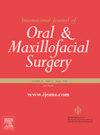用于对比增强计算机断层扫描图像中颌骨肿瘤自动分割和分类的深度卷积神经网络。
IF 2.2
3区 医学
Q2 DENTISTRY, ORAL SURGERY & MEDICINE
International journal of oral and maxillofacial surgery
Pub Date : 2024-10-15
DOI:10.1016/j.ijom.2024.10.004
引用次数: 0
摘要
本研究旨在评估基于卷积神经网络(CNN)的图像分割模型在对比增强计算机断层扫描(CT)图像中对良性和恶性颌骨肿瘤进行分割和分类的性能。数据集由 3416 张 CT 图像组成(其中 1163 张显示良性颌骨肿瘤,1253 张显示恶性颌骨肿瘤,1000 张无病理病变),这些图像来自泰国的一家肿瘤医院和两家地区医院;这些图像来自 2016 年至 2020 年间的 150 名颌骨肿瘤患者。采用 U-Net 和 Mask R-CNN 图像分割模型。对 U-Net 和 Mask R-CNN 进行了训练,以区分良性和恶性颌骨肿瘤,并对 CT 图像中的颌骨肿瘤进行分割以识别其边界。在测试数据集上评估了每个模型在 CT 图像中分割颌骨肿瘤的性能。所有模型的准确率都很高,分割的 Dice 系数为 0.90-0.98,Jaccard 指数为 0.82-0.97,良性和恶性颌骨肿瘤分类的精度-召回曲线下面积为 0.63-0.85。总之,基于 CNN 的分割模型在对比增强 CT 图像中的颌骨肿瘤自动分割和分类方面表现出了巨大的潜力。本文章由计算机程序翻译,如有差异,请以英文原文为准。
Deep convolutional neural network for automatic segmentation and classification of jaw tumors in contrast-enhanced computed tomography images
The purpose of this study was to evaluate the performance of convolutional neural network (CNN)-based image segmentation models for segmentation and classification of benign and malignant jaw tumors in contrast-enhanced computed tomography (CT) images. A dataset comprising 3416 CT images (1163 showing benign jaw tumors, 1253 showing malignant jaw tumors, and 1000 without pathological lesions) was obtained retrospectively from a cancer hospital and two regional hospitals in Thailand; the images were from 150 patients presenting with jaw tumors between 2016 and 2020. U-Net and Mask R-CNN image segmentation models were adopted. U-Net and Mask R-CNN were trained to distinguish between benign and malignant jaw tumors and to segment jaw tumors to identify their boundaries in CT images. The performance of each model in segmenting the jaw tumors in the CT images was evaluated on a test dataset. All models yielded high accuracy, with a Dice coefficient of 0.90–0.98 and Jaccard index of 0.82–0.97 for segmentation, and an area under the precision–recall curve of 0.63–0.85 for the classification of benign and malignant jaw tumors. In conclusion, CNN-based segmentation models demonstrated high potential for automated segmentation and classification of jaw tumors in contrast-enhanced CT images.
求助全文
通过发布文献求助,成功后即可免费获取论文全文。
去求助
来源期刊
CiteScore
5.10
自引率
4.20%
发文量
318
审稿时长
78 days
期刊介绍:
The International Journal of Oral & Maxillofacial Surgery is one of the leading journals in oral and maxillofacial surgery in the world. The Journal publishes papers of the highest scientific merit and widest possible scope on work in oral and maxillofacial surgery and supporting specialties.
The Journal is divided into sections, ensuring every aspect of oral and maxillofacial surgery is covered fully through a range of invited review articles, leading clinical and research articles, technical notes, abstracts, case reports and others. The sections include:
• Congenital and craniofacial deformities
• Orthognathic Surgery/Aesthetic facial surgery
• Trauma
• TMJ disorders
• Head and neck oncology
• Reconstructive surgery
• Implantology/Dentoalveolar surgery
• Clinical Pathology
• Oral Medicine
• Research and emerging technologies.

 求助内容:
求助内容: 应助结果提醒方式:
应助结果提醒方式:


